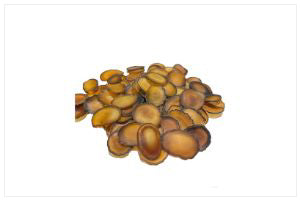Deer Antlers, also known as Cervi Pantotrichum Cornu or Pilose Antler in traditional Chinese medicine (TCM), are derived from the young, non-ossifying, and velvety antlers found on the heads of Cervus nippon Temminck or Cervus elaphus L., both belonging to the Cervidae family.
Antlers are growing each year, they are covered by soft membrane named “velvet,” that functions to provides the required nutrients to the developing antlers as they develop bone mass. The velvet is rich in many different substances, including proteins, minerals, amino acids, and Growth-Factor 1. Growth-Factor 1 is a protein hormone with a molecular structure like insulin. The growth phase for antlers takes about 2 to 4 months for most species of deer. Antler growth becomes slower during the summer when testosterone levels are higher. During this time, the arteries and veins found around the velvet become smaller, impeding the supply of blood and nutrients. The deer will eventually rub the antlers against trees to make the velvet fall off in a process called velvet shedding.
Deer Antler Vs Deer Horns
Part of the reason for this is the fact that deer use their antlers for specific reasons during the breeding season and being use when defending themselves against predators. Shedding the antlers every season gives the deer the chance to grow new ones that are stronger and more useful.
Antlers contains substantial amounts of protein and water as they are developing and eventually ossify become completely bone-like texture. Deer shed their antlers when their testosterone falls after mating, also known as their rut. This hormone decrease causes a weakening of the pedicle, which is the tissue and bone at the base of the antler, in short pedicles is the point of the deer’s head from which the antlers grow. The process of the pedicle weakening and the antlers falling off can occur quite rapidly. When the antlers are shed, they fall from the pedicles. Even if a deer’s antlers are secure on the head on one day, they may end up falling off within 1 – 2 days.
Importantly, deer horn is when antler growth has ceased, calcification has occurred, and the skin, nerve and blood supply are no longer functional. The deer are not harmed during the antler harvesting process, as these antlers can naturally regenerate during the summer months. For medicinal use, the hair on the Deer Antlers is incinerated, and then the antlers are sliced and dried.
Related Content:
Deer Antler: Nature's Health Booster & Its BenefitsAvailable In-Store

Why Buy Deer Antler from Yue Hwa?
Since 1959, Yue Hwa has been a reputable provider of premium Chinese products, ensuring that every purchase you make is genuine.

